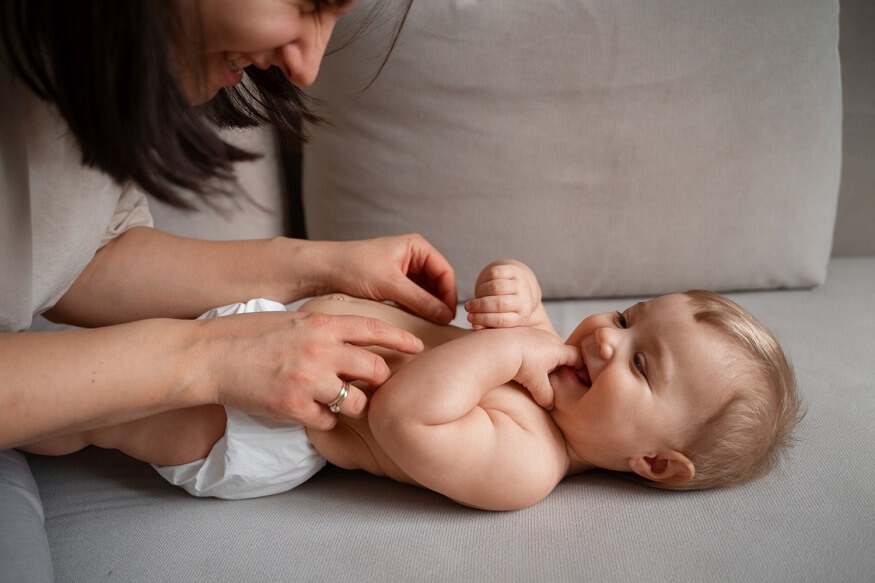Tickling, a time-honoured form of play cherished by both young and old, has long been seen as a harmless and joyful activity for children. The giggles and laughter that echo through the room during tickle play seem to signify innocent amusement and carefree fun. However, beneath its innocent facade lie subtle dangers that can impact a child’s emotional well-being. We will delve into the concealed perils of tickling and tickle play, urging parents and caregivers to be mindful of its potential negative effects on their little ones’ overall development and emotional growth.
Also Read: Toy Safety for Kids
1. Types of Tickling and Tickle Play
1.1 Knismesis: A Gentle Tingle
Knismesis refers to the light, gentle tickling that produces a subtle tingling sensation on the skin. These types of tickling are often experienced when something soft brushes against the skin, such as a feather or a light touch. While it may not induce intense laughter, it creates a mild, pleasurable sensation that can be quite enjoyable for some children.
1.2 Gargalesis: Laughter and Wriggling
On the other hand, gargalesis involves a more intense form of tickling that triggers laughter and squirming in response. These types of tickling are frequently connected to amusing exchanges between parents, carers, and kids. It typically happens on the body’s most delicate regions, including the feet and underarms, and can cause excessive giggling and joyous emotions, transforming playing into a wonderful opportunity for bonding.
2. The Importance of Boundaries and Consent
2.1 The Impact of Over-enthusiastic Tickle Play
While tickle play can be a source of amusement and connection, it is crucial to recognize that over-enthusiastic tickling play might inadvertently cross a child’s boundaries. Children may not possess the vocabulary or communication skills to express their discomfort effectively, leading to potential discomfort or distress during the play. Caregivers must be attuned to the child’s cues and be mindful of the intensity of tickling to ensure that it remains an enjoyable and consensual experience.
2.2 Nurturing Trust through Respecting Personal Space
Respecting a child’s personal space and boundaries during tickle play is essential in nurturing a trusting and secure relationship. When caregivers acknowledge a child’s cues and verbal or non-verbal expressions of discomfort, they demonstrate respect for the child’s autonomy, promoting a positive and safe environment for playful interactions. By establishing trust through respectful play, children learn to feel secure and valued, enhancing their emotional well-being.
3. Unmasking Unintended Trauma and Anxiety
3.1 Overcoming Stereotypes: Laughter Doesn’t Always Mean Joy
It is a common misconception that laughter during tickling indicates unequivocal enjoyment. Children may laugh during tickling play as a response to the tickling itself or to please the adults involved, even if they find the experience overwhelming or uncomfortable. It is vital to differentiate between genuine enjoyment and forced laughter to avoid unintentional emotional distress.
3.2 Coping Mechanisms: The Emotional Impact of Tickling
Tickling can serve as a coping mechanism for children to manage uncomfortable situations. Laughing and appearing to enjoy tickling might be a child’s way of minimising feelings of vulnerability or fear. Understanding these coping mechanisms can help caregivers create a more emotionally supportive environment for the child. By validating the child’s emotions and providing reassurance, caregivers can help children navigate emotional challenges more effectively.
4. Empowering Autonomy in Tickle Play
4.1 Fostering Self-expression and Assertiveness
Encouraging children to express their feelings and preferences during tickle play empowers them to assert their boundaries confidently. To make sure that a kid feels in control and appreciated during playtime, carers should pay close attention to both verbal and nonverbal indications from the child. Caretakers can increase a child’s feeling of agency and value by recognizing and responding to the child’s choices.
4.2 The Connection Between Tickle Play and Setting Boundaries
Tickle play can serve as a valuable opportunity to teach children about setting and respecting boundaries. By engaging in tickle play that involves mutual consent and awareness of each other’s comfort levels, children can learn valuable lessons about boundaries, consent, and communication.
Also Read: Harmful Effects of Junk Food on Students
5. The Crucial Role of Trust and Attachment
5.1 Building Strong Parent-Child Relationships
A strong relationship between parents and children is built on trust. Respecting limits during tickle play can help children develop stronger emotional attachments and a more stable attachment by reaffirming their idea that their carers will put their needs first. By cultivating trust through positive interactions, caregivers create a nurturing environment where children feel safe and supported in their emotional exploration.
5.2 Navigating the Impact of Unwanted Tickling on Attachment
Unwanted or excessive tickling has the potential to sever a child’s caregiver-child connection tie. The child’s mental well-being may suffer because it erodes their feeling of security and trust. Carers can contribute to the development of a more stable connection by being aware of the child’s emotions and upholding courteous relationships.
6. Ensuring Physical Safety During Tickle Play
6.1 Minimising Accidents and Injuries
Tickling can induce spontaneous movements in children, which may lead to accidents. Ensuring a safe play environment, free of sharp objects or hazards, can reduce the risk of injury during tickle play. By maintaining a safe and supervised play environment, caregivers can focus on nurturing the emotional well-being of the child without compromising their physical safety.
6.2 Addressing Health Concerns during Boisterous Laughter
Excessive tickling-induced laughter may be harmful to a child’s health if they have a disease like asthma. When playing with kids, carers should be aware of these circumstances and take the necessary procedures to protect their safety and wellbeing. Caretakers may modify tickle play to meet the requirements of the kid and make it a safe, fun experience for them by being mindful of any potential health risks.
Also Read: 10 Harmful Effects of Using Mobile Phones on Children
7. A Mindful Approach to Tickle Play
7.1 Embracing Alternative Forms of Play
While tickle play can be enjoyable, diversifying playtime with other activities can enrich a child’s experience and strengthen the bond between caregivers and children. Exploring different forms of play encourages creativity and allows for a broader range of positive interactions. By embracing a variety of play activities, caregivers can engage in meaningful and enjoyable interactions that cater to the child’s unique interests and preferences.
7.2 Communicating and Understanding Children’s Needs
Open communication with children is vital in understanding their preferences and emotional responses during play. Regularly conversing with kids about their emotions and life events can deepen relationships and result in more meaningful playtime interactions. Carers may better meet the needs of the kid by actively listening to their ideas and emotions.
Conclusion:
At Euroschool, we place paramount importance on the all-encompassing growth and happiness of every child entrusted to our care. While tickling might appear as innocent amusement, it is crucial to acknowledge the potential harm it can entail. Tickling children without respecting their boundaries and consent can inadvertently lead to emotional distress and weaken the trust between a child and their caregivers. Our approach to nurturing children’s emotional development revolves around fostering transparent communication, empowering self-expression, and creating a secure and considerate atmosphere during playtime. By remaining vigilant of the concealed risks associated with tickle play, we are committed to safeguarding each child’s emotional well-being, ensuring a nurturing and uplifting learning experience for all.










